
About UsThe Numismatic Bibliomania Society is a non-profit organization promoting numismatic literature. For more information please see our web site at coinbooks.org SubscriptionsThose wishing to become new E-Sylum subscribers (or wishing to Unsubscribe) can go to the following web page link MembershipThere is a membership application available on the web site Membership Application To join, print the application and return it with your check to the address printed on the application. Membership is only $15 to addresses in the U.S., $20 for First Class mail, and $25 elsewhere. For those without web access, write to: David M. Sundman, Secretary/TreasurerNumismatic Bibliomania
Society AsylumFor Asylum mailing address changes and other membership questions, contact David at this email address: dsundman@LittletonCoin.com SubmissionsTo submit items for publication in The E-Sylum, just Reply to this message, or write to the Editor at this address: whomren@coinlibrary.com
BUY THE BOOK BEFORE THE COINYou won't regret it! |
- WAYNE'S WORDS: THE E-SYLUM MARCH 8, 2009
- MARCH 2009 ISSUE OF THE BOOKSHELF AVAILABLE
- MARCH 5, 2009 KOLBE AUCTION SALE RESULTS
- NEW BOOK: THE FANTASTIC 1804 DOLLAR TRIBUTE EDITION
- REMINDER: THE COIN COLLECTOR'S JOURNAL SURVEY
- NEW CD: SILVER FEVER: THE COMSTOCK LODE TO THE CARSON CITY MINT
- SUBSCRIBER PROFILE: ALBERTO PAASHAUS
- MERCANTI NAMED 12TH CHIEF ENGRAVER OF THE U.S. MINT
- QUERY: LOCATION OF CIVIL WAR HUNTING PARTY VIGNETTE SCRIP ISSUER SOUGHT
- QUERY: AN INTERESTING SET OF MEDAL ELECTROTYPES
- MORE ON NEGATIVE SHADOW AND SURFACE DISPLACEMENT
- NEW TERM IN NUMISMATICS: WOODGRAIN
- QUERY: REFERENCE ON WWI CITY AND STATE MILITARY SERVICE MEDALS
- HAPPY WHILE UNITED INDIAN PEACE MEDAL PURCHASED BY COLONIAL WILLIAMSBURG
- NUMISMATOURIST HOWARD BERLIN ON NUMISMATIC MUSEUMS
- MALAYSIA'S MONEY MUSEUM
- SOUTH CAROLINA SELLS CACHE OF OBSOLETE BANKNOTES
- PRESIDENTIAL FOOD SERVICE COINS
- A JOURNEY THROUGH THE MONKALOKIAN RAIN FORESTS IN SEARCH OF THE SPINEY FUBBADUCK
- PAPER MONEY ARTICLE FOCUSES ON BERKSHARES
- MEXICO CITY MINT STRIKES TOKEN FOR LONDON'S WHITECHAPEL GALLERY
- STANFORD SUIT FREEZES GOLD BARS SLATED FOR EXHIBIT
- MISSOURI COIN CAPSULE SCAM FLEECES INVESTORS
- OPERATION BERNHARD COUNTERFEITER ADOLF BURGER INTERVIEWED
- COMMENTATOR PAUL HARVEY, COIN COLLECTOR, DIED AT 90
- ARTICLE: BANK OF ENGLAND TO PUT RELIGIOUS LEADERS ON BANKNOTES
- COLOGNE, GERMANY TOWN ARCHIVE BUILDING COLLAPSES
- FEATURED WEB SITE: THE E-GOBRECHT ARCHIVES
WAYNE'S WORDS: THE E-SYLUM MARCH 8, 2009
 Among our recent subscribers are Ruth Wilcoxen, courtesy of Ron Abler, and Charlene Myers. Welcome aboard! We now have 1,216 subscribers.
Among our recent subscribers are Ruth Wilcoxen, courtesy of Ron Abler, and Charlene Myers. Welcome aboard! We now have 1,216 subscribers. This week we open with information from numismatic booksellers David Fanning and George Kolbe. Next up is a new book, a "tribute edition" of The Fantastic 1804 Dollar.
Queries this week include an interesting obsolete scrip note vignette, a set of electrotypes of 19th century gems and medals, and WWI military "welcome home" medals.
In the news, we now have a "new" Chief Engraver of the U.S. Mint, a Missouri-based coin capsule investment scam, and a state archive sale of confederate-era southern banknotes.
It's been a good weekend in the Homren household. On Saturday Christopher and Tyler picked up a trophies for their 3rd/4th grade basketball team's second place season finish, and Tyler got the Coach's award. Today I took the training wheels off four-year-old Hannah's bicycle, and soon she was off riding on her own like she'd always done it that way. Dad stayed up 'til midnight working on his newsletter, but had fun doing it.
Anyway, to learn about numismatics and the Spiney Fubbaduck, read on. Have a great week, everyone!
Wayne Homren
Numismatic Bibliomania Society
MARCH 2009 ISSUE OF THE BOOKSHELF AVAILABLE
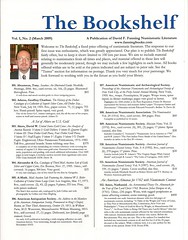 David F. Fanning Numismatic Literature has announced the publication of the March issue of The Bookshelf, their latest fixed price list of numismatic literature. The publication has mailed, and should be received by established customers soon if they haven't received it already. It is also available in PDF form on the company's Web site at www.fanningbooks.com. A direct link is: www.fanningbooks.com/Bookshelf1.2Web.pdf.
David F. Fanning Numismatic Literature has announced the publication of the March issue of The Bookshelf, their latest fixed price list of numismatic literature. The publication has mailed, and should be received by established customers soon if they haven't received it already. It is also available in PDF form on the company's Web site at www.fanningbooks.com. A direct link is: www.fanningbooks.com/Bookshelf1.2Web.pdf. The list includes 100 lots of numismatic literature from around the world, and features a number of moderately priced items in addition to a few highlights. David Fanning can be reached at dfanning@columbus.rr.com.
MARCH 5, 2009 KOLBE AUCTION SALE RESULTS
In part two of the Twinleaf library, the Breen/Vogel work on 1816-1857 brought $977 on a $150 estimate, Elder’s plated 1908 Wilson sale brought $747 and his 1910 Mougey sale with original plates realized $2,300.
Other highlights included a nice reprint set of Habich on Renaissance medals, which brought $1,380, Du Bois’s rare 1846 Pledges of History, the first work on the coin collection at the Philadelphia Mint, which sold for $1,265; and a little-known 1974 special convention issue of the Red Book. Estimated at $250, it ended up bringing $402.
Kolbe’s next sale is scheduled for June 11th, 2009 and will feature a wide variety of useful and desirable numismatic works. The catalogue will be accessible a month before the sale at www.numislit.com or printed copies may be ordered by sending $15.00 to George Frederick Kolbe, P. O. Drawer 3100, Crestline, CA 92325. Telephone: (909) 338-6527; Fax: (909) 338-6980; Email: GFK@numislit.com.
NEW BOOK: THE FANTASTIC 1804 DOLLAR TRIBUTE EDITION
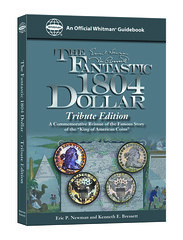 Whitman Publishing announces the release of The Fantastic 1804 Dollar, Tribute Edition, by Eric P. Newman and Kenneth E. Bressett.
Whitman Publishing announces the release of The Fantastic 1804 Dollar, Tribute Edition, by Eric P. Newman and Kenneth E. Bressett. Numismatic impresario B. Max Mehl made this remark back in 1941—and it still holds today.
With all the publicity and honor showered on the famous 1804 silver dollar, the “King of American Coins” remains the hobby’s most celebrated and intriguing rarity.
This new book is a commemorative reissue of The Fantastic 1804 Dollar (1962), the groundbreaking study by hobby legends Eric Newman and Kenneth Bressett. It celebrates the 50-year anniversary of the start of their collaboration.
A complete reprint of the original book is expanded with several new, full-color chapters. The additional material includes:
“The first edition of this classic book has been out of print for years,” said Whitman publisher Dennis Tucker. “Now, with the new Tribute Edition, every coin collector has the opportunity to learn about these fascinating coins, from two of the hobby’s greatest writers.”
The Fantastic 1804 Dollar, Tribute Edition, is 208 pages. It has a hard cover with silver-foil titling. The book is available online at www.WhitmanBooks.com, and in bookstores, hobby shops, and other retailers nationwide. The hardcover retails for $19.95; a Limited Edition (250 specially bound copies autographed by both Newman and Bressett) is available for $49.95.
LAKE BOOKS
Our 97th mail-bid sale of numismatic literature features
selections from the library of John T. Hamilton III, Part Two
(and other consignors)
- Lot B8 - Jess Peters' sale of Ray Byrne's collection of Coins, Tokens and Medals from the West Indies - hardbound
- Lot E7 - British Numismatic Society -1908 - Journal - hardbound
- Lot E9 - Canadian Numismatic Journal - 1956 - Volume I - hardbound
- Lot E18 - T. Eypeltauer - Corpus Nummorun Regni Mariae Therisiae hardbound in green cloth
- Lot E22 - M. Greenwood - ...In Search of the Spiny Fubbaduck
- Lot E47 - Dec,1885 - Royal Asiatic Society Journal
- Lot F16 - the four-volume set of Haxby's U.S. Obsolete Bank Notes
- Lot H80 - a three-volume set of George Williamson's Trade Tokens Issued in the Seventeenth Century
- Lot I5 - a Special Presentation Edition of The Invasion of Louisville bound in red leather by Alan Grace and presented to George Fuld
REMINDER: THE COIN COLLECTOR'S JOURNAL SURVEY
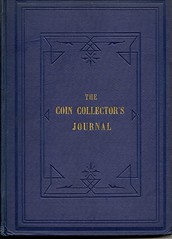
E-Sylum readers and NBS members alike are encouraged to participate. If you have an examples of this great publication in your library, please take a moment to complete the short survey form and submit it to Leon at h.majors@comcast.net Thanks. -Editor
To access the survey form on the NBS web site, see: Coin Collector Journal Survey (http://www.coinbooks.org/ccjlog.html)
NEW CD: SILVER FEVER: THE COMSTOCK LODE TO THE CARSON CITY MINT
The innovative and entertaining CD Silver Fever: The Comstock Lode to the Carson City Mint features the colorful story of the silver strike on the Comstock, information about the historic Carson City Mint, details about how the ore was extracted, and insight into the dangers the Comstock miners faced.
In addition, this MAC and PC compatible CD contains:
- In-depth features about the history, lore and collecting of Carson City's gold and silver coins
- Pricing for all coin series and designs struck by the Carson City Mint
For more information, or to order, see: Silver Fever: The Comstock Lode to the Carson City Mint CD, The Comstock Lode to the Carson City Mint (www.fwmagazines.com/product/1535/77)
SUBSCRIBER PROFILE: ALBERTO PAASHAUS
"Buy the book before the coin" is something definitely strong. You might not feel that much in America, where most of the dealers cultivate the feeling of having books surrounding them for reference or at least as a nice decoration - but they are there! Unfortunately, that doesn´t happen back in Brazil, which explains a lot the very limited issues of old reference books very important to understand its numismatic history, one of the most important in the world.
Now I am a very proud owner of an almost 100% read library of about 600 books, counting the magazines and bulletins, that expands almost every week with a new addition for the last two years, when I started dedicate myself to a proper book collection on Brazilian Numismatics.
Books and documents range from the 17th Century works up to our days, with many rarities, as an almost complete Meili collection (just one to go - people say you become a powerful collector when you get all his 7 works from the series Numismatisch Geldwessen and Numismatisch Samlung - just like on those Japanese cartoons - I couldn´t help it!).
This year is the year for books (my coin collection purchases will remain in "slow motion" in 2009) and I intend to write something this year on Brazilian Numismatics Books for a Portuguese Bulletin and I will surely have it translated and submitted here at The E-Sylum. I hope I can help you guys with anything you might need!
THE BOOK BAZARRE
MERCANTI NAMED 12TH CHIEF ENGRAVER OF THE U.S. MINT
Mercanti, who was previously the “Supervisory Design and Master Tooling Development Specialist,” has been working for the US Mint since 1974 and has been responsible for the design of some of the Mint’s most spectacular coins of the last 35 years. Mercanti worked under Chief Engravers Frank Gasparro and Elizabeth Jones.
After Jones retired in 1990, the US Mint abolished the position of Chief Engraver. After 19 years, Director Edmund C. Moy has decided to bring back the position and offer the job to the Mint’s most experienced and accomplished engraver. Mercanti deserves the honor to join this elite group:
- Robert Scot 1793-1823
- William Kneass 1824-1840
- Christian Gobrecht 1835-1844
- James Barton Longacre 1844-1869
- William Barber 1869-1879
- Charles Edward Barber 1879-1917
- George T. Morgan 1917-1925
- John R. (Ray) Sinnock 1925-1947
- Gilroy Roberts 1948-1964
- Frank Gasparro 1965-1981
- Elizabeth Jones 1981-1990
- John M. Mercanti 2009-present
I later learned from someone in the audience at the event that the news came as a surprise to Mercanti; Moy stated that the approval came from The White House to remedy this longstanding slight. -Editor
To read the original blog post, see: Mercanti Named 12th Chief Engraver (coinsblog.blogspot.com/2009/02/mercanti-named-12th-chief-engraver.html)
QUERY: LOCATION OF CIVIL WAR HUNTING PARTY VIGNETTE SCRIP ISSUER SOUGHT
Steve Whitfield writes: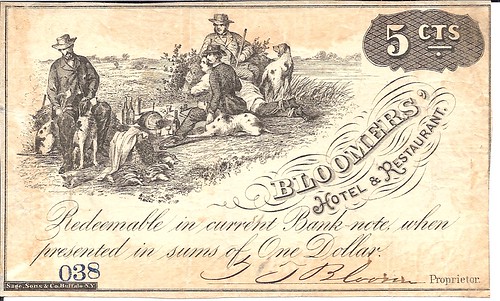
I was unable to locate information about this particular vignette, but bibliophiles might want to look for notes with the vignettes of Oglethorpe at Christie's Sale of Dr. Johnson's Library (vol III, p118) or Literature by Asher D. Durand (vol II, p39). -Editor
QUERY: AN INTERESTING SET OF MEDAL ELECTROTYPES
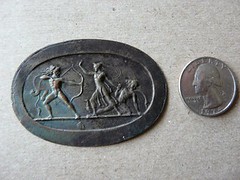 Ken writes: "These items were purchased from an estate an hour outside Toronto, Canada. The owners were of European descent and said the items had been passed down from their father. The collection itself was stored loosely in a box with other documents and miscellaneous items. The focus of the acquisition was a collection of WWI correspondence from a front line soldier."
Ken writes: "These items were purchased from an estate an hour outside Toronto, Canada. The owners were of European descent and said the items had been passed down from their father. The collection itself was stored loosely in a box with other documents and miscellaneous items. The focus of the acquisition was a collection of WWI correspondence from a front line soldier."Below is a link to a slide show of the both sides of each of the 48 pieces. -Editor
I asked Christopher Eimer about these. He writes:
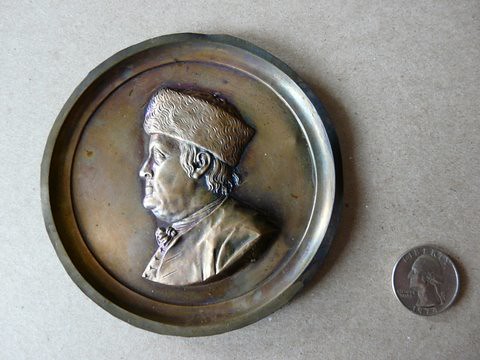
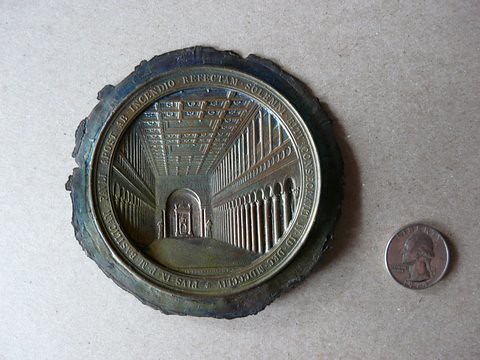
To view a complete slide show, see: www.flickr.com/photos/coinbooks/sets/72157614731090778/show/
MORE ON NEGATIVE SHADOW AND SURFACE DISPLACEMENT
Regarding negative shadow and surface displacement toning effects, Ron Thompson writes: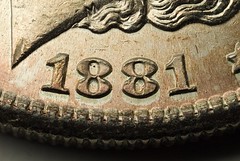 I thought I would add my two cents worth on the discussion. I don't think it is an either or situation, I think both Dick Johnson and Pete Smith are right.
I thought I would add my two cents worth on the discussion. I don't think it is an either or situation, I think both Dick Johnson and Pete Smith are right. First, I believe the big central voids in the dies are filled and then, as the pressure continues, the metal continues to flow to fill the last voids at the extremes. This would be the highest points as well as the edges. If Dick has any process sets I sure he can confirm that some of the last areas to be filled are the edges.
If too much pressure is applied the metal flows out of the joint between the dies and the collar and we get the wire rim effect.
To me, none of this really explains the negative shadow effect. My guess is that the higher areas (the numbers, letters etc) and the raised rim protect that lower narrow surface area from exposure, sort of like sunglasses protect the areas around the eyes from sunburn.
However, while that may somewhat explain it, that doesn't explain the lack of toning due to exposure to the air. There may be some micro electrostatic or magnetic field created by the final flow of the metal between the small low area and the surrounding high points that in essence repels oxidizing particles and this field may be protected by the high areas on either side of it. Anyway, it certainly is interesting.
In his March 7th blog A Gift For Polydektes, Ed Snible referenced Dick Johnson's E-Sylum submission on this effect. He writes:
The most detailed explanation on Moneta-L came from a post by Robert Kokotailo of Calgary coin. I wonder if this is the same effect?
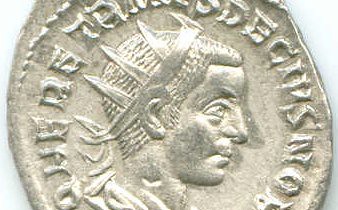
I'm glad to have a name for it! (If it is the same phenomenon.) The name most popular on Moneta-L was 'ghosting', which is also a technical term in numismatics for clashed die errors that leave a 'ghost' of the type on one side upon the other.
NEW TERM IN NUMISMATICS: WOODGRAIN
 Several mentions have been made in the blogs recently of a new term applied to the surface of Lincoln cents: woodgrain. The term is apt. The illustrated surface of an 1981-D cent does indeed look like the graining in wood.
Several mentions have been made in the blogs recently of a new term applied to the surface of Lincoln cents: woodgrain. The term is apt. The illustrated surface of an 1981-D cent does indeed look like the graining in wood.While this may be considered an anomaly of toning, instead it is an anomaly of the metal composition. It is an error in mixing of copper and zinc. What you see on the surface are streaks of copper alternating with streaks of zinc. The metal in the blank is not one homogeneous mixture as it should be to form one uniform color; it exists even after rolling, blanking and striking. The surface shows this streaking.
The Denver Mint in 1981 was pushing through 5.37 billion cents in a year's time. Some shortcuts were taken whether the Mint was buying its strips from outside suppliers or formulating their own coinage metal and rolling it themselves. The metal did not get mixed properly to achieve that homogeneous (all alike) composition before any manufacturing process.
The formulation at the time was 19 parts copper to one part of zinc (this was a year before the copper coated zinc used for cent coinage since 1982). Mixing zinc and copper throughout is not easy and I have the greatest respect for those craftsmen and metalworkers who accomplish this.
The melting points are different -- zinc at 785 degrees Fahrenheit, copper at 1220 degrees F. If you are not careful the zinc can burn off before it is adequately mixed with molten copper. Takes a lot of skill. Streaks result from not thoroughly mixing the batter.
To read the blog article, see: 1981D woodgrain cent (http://www.cointalk.com/forum/t49005/)
QUERY: REFERENCE ON WWI CITY AND STATE MILITARY SERVICE MEDALS
In all the books in my library I can't find even a whisper about these State and City type medals. Searching Online gets similar results except for info about the national rainbow ribboned Allied Peace & Victory medals that each of the participating countries issued at the armistice.
James Earl Fraser designed ours. But I think these Victory medals have to be considered national military service awards. -- If any of our E-Sylum readers can steer me towards a reference dealing with the civilian medals given by cities and states I sure would appreciate the help.
HAPPY WHILE UNITED INDIAN PEACE MEDAL PURCHASED BY COLONIAL WILLIAMSBURG
"The Virginia Indian Peace Medal is a priceless addition to the Colonial Williamsburg collection," says Erik Goldstein, curator of numismatics and mechanical arts, in a news release.
"It is an integral part of Virginia history that acknowledges and honors the Native American allies of Virginia's infant revolutionary government."
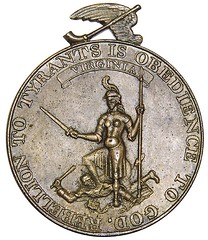
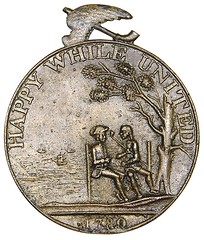
Produced by order of Jefferson in 1780, the "Happy While United" medal commemorated an alliance between the region's native tribes and the commonwealth.
Silver versions were presented to important tribal members, while bronze versions were cast for nonnative recipients. None of the silver medals survive.
The medal will be exhibited at the DeWitt Wallace Decorative Arts Museum at Colonial Williamsburg starting March 28. The foundation did not list the purchase price of the medal.
To read the complete article, see: Colonial Williamsburg acquires extremely rare medal (www.wtop.com/?nid=25&sid=1615909)
To read the complete Stack's lot description, see: State of Virginia. Happy While United Medal, 1780. (http://www.stacks.com/lotdetail.aspx?lsid=AN00000673&asid=&lrid=AN00116589)
NUMISMATOURIST HOWARD BERLIN ON NUMISMATIC MUSEUMS
In the last five years I have crossed the Atlantic 50 times, visited almost 40 museums in 11 countries. The museums range from a virtual one man show such as Eric Newman’s money museum on the campus of Washington University (my alma mater) in St. Louis, city museums throughout Europe, to large museums like Berlin’s Bode Museum.
in 2008 alone, I visited the British Museum (for the umpteenth time), Monnaie de Paris, The Nationalmuseet-Royal Collection of Coins and Medals (Copenhagen), The National Museum-The Royal Coin Cabinet (Stockholm), Bank of Canada Currency Museum (Ottawa), Federal Reserve Bank of Chicago, Balzekas Lithuanian Museum (Chicago), National Museum of Scotland (Edinburgh), HBOS on the Mound (Edinburgh), Hunterian Museum (Glasgow), Manchester Museum, and the Hamburg Museum. Eventually all these will be written about in future WorldWide Coins columns.
The purpose of my column is twofold. I realize that not everyone is able to travel extensively and independently as I do. So, I try to give my readers the experience of these museums they would otherwise never have the opportunity to visit. For those readers who might be visiting that particular city, the column makes them aware of the museum and its exhibits.
If it were not for these museums, I wouldn’t have a column to write, telling my readers about the treasures that are on display. Many of the city museums focus on the local history and integrate numismatics into their exhibits which, for me, adds a bit to the overall experience.
As a former exhibitor in ANA, national, regional, and local shows, I now personally like to examine the manner in which the coins and banknotes are mounted and displayed in museum exhibits. Also, I get to meet some pretty important people – museum directors and curators, often leaving with gifts of pamphlets and books.
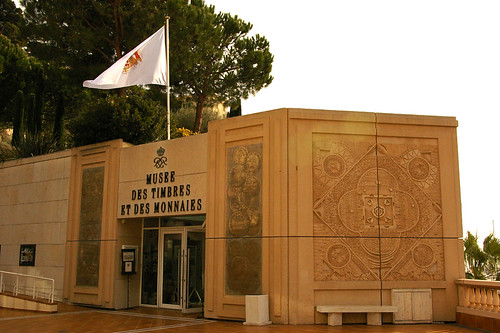
I would like to ask a question of E-Sylum readers. I am considering writing a book, called, “The Numismatourist: A world-wide travel guide to the museums, mints, and other places of interest for the numismatist.” So far I have cataloged over 80 locations, such as museums and mints whose exhibitions or tours are open to the public in North and Central America, the Caribbean, Europe, Asia, the Middle East, Africa, and Australia. Private university collections are not included. Many of these I will have visited but for others, the information will be obtained from other sources.
I envision such a travel guide having a trim size around 5” x 8” which is small enough to be placed in a pocket, purse, or small travel bag. In addition. Each venue would fit on it own page and have at least one picture – that of the outside of the building, so the reader will have visual idea of what it looks like when looking for it. If there is a outstanding coin that is one of the “highlights” of its collection, it could be added to fill up any needed space with the text so that each venue has its own page.
The text would give a concise description of the venue and what the visitor would expect to see. It would also include information as to its address, telephone number(s), web site, and hours of operation. I would also like to include icon symbols representing features such whether or not the venue is handicapped accessible, photography is permitted, admission fee, or if multi-language audio-guides are available. If there is an admission fee, I would not specifically quote it (in the local currency) as it as it could be subject to change.
Like other authors have written here, one of the major numismatic publishers has “passed” on this idea, citing insufficient numbers, etc. I have written 31 books (all with noted publishers) and although I’m not crazy about self publishing/print on demand, I would consider it as a last resort. I would like any feedback from E-Sylum readers if you think you such a book is a worthy project (no commitment to buy anything). You can reach me at numismatourist@yahoo.com with any comments or suggestions.
MALAYSIA'S MONEY MUSEUM
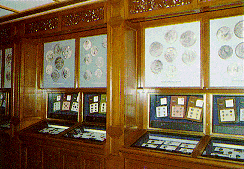 I believe many of our collectors are not aware of the existence of the Bank Negara Malaysia's Money Museum. Or even some are aware but many of them have yet to pay a visit to this Money Museum. Personally, I have visited this Money Museum, which was located at the BNM building at Jalan Dato Onn, several times before it was announced to be closed on 2 July 2007 for its upgrading works.
I believe many of our collectors are not aware of the existence of the Bank Negara Malaysia's Money Museum. Or even some are aware but many of them have yet to pay a visit to this Money Museum. Personally, I have visited this Money Museum, which was located at the BNM building at Jalan Dato Onn, several times before it was announced to be closed on 2 July 2007 for its upgrading works.Over the century, the Bank Negara has managed to build up a collection of various kind of Malaysian old money tokens, rare coins and currency notes. With the introduction of Money Museum by Bank Negara Malaysia, the public was given an opportunity to view and enjoy the BNM's currency collection.
The BNM's numismatic collection has covered the area of Malaysian currency items comprising of primitive money, barter trade currency, pre-colonial Malay State money, colonial period money, independence period money and not forgetting the BNM issuance currency.
The main objective of the Money Museum is to serve as a permanent repository for the Malaysian numismatic heritage through the study and preservation of items related to the historical development of currency system in Malaysia. The museum has provided a permanent display of coins, bank notes and other monetary items evolved over the various phases of Malaysian history.
Since the closure of Money Museum in 2007, the BNM has increased the pace of constructing a new home for Money Museum. The new Money Museum and Art Gallery of Bank Negara Malaysia is going to re-open with a brand new outlook in May 2009.
To read the complete article, see: Money Museum Malaysia (malaysianbanknotes.blogspot.com/2009/03/money-musuem-malaysia.html)
SOUTH CAROLINA SELLS CACHE OF OBSOLETE BANKNOTES
The surplus property division of the S.C. Budget and Control Board has listed the Civil War-era money for sale on eBay. For instance, the starting bid for a canceled $4 bank note — issued from the Bank of the State of South Carolina, which collapsed during the Civil War — starts at $150.

The Bank of the State of South Carolina was one of the few banks of the era operated by a state; it was founded in 1812.
“With the state budget cuts, we’ve lost about one-third of our budget in recent years,” said Charles Lesser, senior archivist for the department. “We’re in very dire budgetary times. This is one way, an imaginative way, of keeping our heads above water. And we’re making space (in the vault). Every little bit helps.”
Should any history buffs be offended by the sale, Lesser was quick to reassure that the state is not selling off any original, precious or last-remaining items from the department’s vault.
He estimated that, at one point, the department had some 1 million sheets of canceled banknotes, if not more.
“The notes were supposed to be destroyed in the 1880s but they were not,” Lesser said.
To read the complete article, see: State sells Confederate-era cash to raise money (www.charlestonbusiness.com/news/26791-
state-sells-confederate-era-cash-to-raise-money)
PRESIDENTIAL FOOD SERVICE COINS
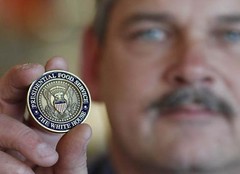 It was business as usual at Broaster Chicken & Ribs Friday, until a woman clad in a dark suit arrived.
It was business as usual at Broaster Chicken & Ribs Friday, until a woman clad in a dark suit arrived.The woman ordered more than five slabs of ribs, manager Bonnie Belaney said, and wanted the meat cut off of the bone and served with extra sauce.
"We accommodated her, but when she got ready to leave, she gave us a coin,'" Belaney said.
Upon closer inspection, Belaney realized the coin said "Presidential Food Service for the White House."
Friday was the day that President Barack Obama visited the area for a speech at Camp Lejeune. The president landed at MCAS Cherry Point Friday morning in Air Force One, took Marine One to Camp Lejeune for a speech to Marines there.
But he apparently had a few White House aides already on the ground doing some reconnaissance maneuvers - at least for local cuisine.
White House spokesperson Gannet Tseggai confirmed the presidential sampling of not only Broaster Chicken, but said an aide was also dispatched to Smithfield's Chicken and Barbeque.
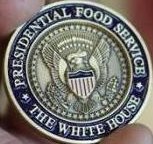 On Friday, a woman entered Smithfield's and went to the counter and asked where she could sit five to seven people, general manager Ken Davis said.
On Friday, a woman entered Smithfield's and went to the counter and asked where she could sit five to seven people, general manager Ken Davis said.After ordering barbeque, beans and potato salad, she left the restaurant, but not before shaking his hand and passing along a coin that Davis assumed was a tip. He told her he couldn't take it. She told him she had to leave it.
"When she left, I looked to see what she gave me. It was a gold coin that said ‘Presidential Food Service for the White House'," Davis said.
To read the complete article, see: Local restaurants get presidential visit (http://www.enctoday.com/news/restaurants_62796
_jdn__article.html/broaster_usual.html)
A JOURNEY THROUGH THE MONKALOKIAN RAIN FORESTS IN SEARCH OF THE SPINEY FUBBADUCK
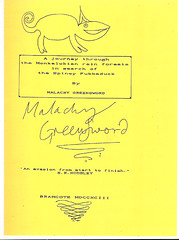 The question about the book, "A Journey Through the Monkalokian Rain Forests in Search of the Spiney Fubbaduck" by Cobwright drew several responses.
The question about the book, "A Journey Through the Monkalokian Rain Forests in Search of the Spiney Fubbaduck" by Cobwright drew several responses.Thomas P. Wolf writes:
Allan Davisson writes:
There will always be an England (and Wales) -- where would we be without them in this otherwise overly serious world? (I have been reading one of Bill Bryson's accounts of British travel--this reference is obviously an expected and perfectly natural product of this island.)
Bob Lyall writes:
To read the original E-Sylum article, see: COBWRIGHT FOUND
THE BOOK BAZARRE
PAPER MONEY ARTICLE FOCUSES ON BERKSHARES
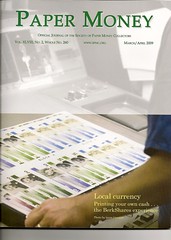
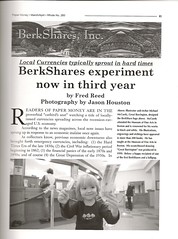
MEXICO CITY MINT STRIKES TOKEN FOR LONDON'S WHITECHAPEL GALLERY
Speaking of alternative currencies, Philip Mernick submitted this item relating to cooperative organization tokens of the past (and an interesting new token of today). Philip writes: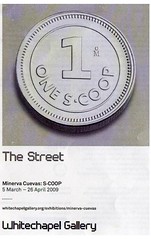
Below is more information on the event from the Whitechapel web site. -Editor
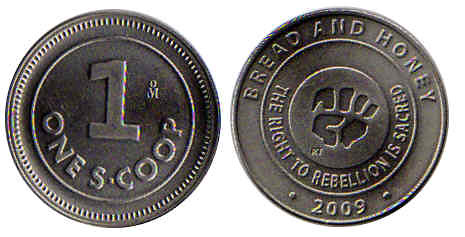
Thursday 5 March, 6.30-9pm
Monochrome, 26-28 Toynbee Street
Join us this Thursday for the launch of Mexican artist Minerva Cuevas’ new commission, S•COOP, for the Whitechapel Gallery.
Located both inside and outside of the Gallery, this project explores the formal and historic links between Petticoat Lane Market, the Whitechapel Gallery archive, and English cooperative movements of the 1900s.
Cuevas assumes the role of political and artistic agent; her works often propose cultural experiments that shadow existing structures and systems, and are realised in spaces that range from the public realm to museums and the internet.
The S•COOP project refers to an economic system that dates back to the 1900s, premised not on state-sanctioned tender, but on tokens offered by English co-operative societies for food and fuel. Designed by Cuevas, the S•COOP coin has been produced by the Mexican Mint to be circulated by east London market traders, in exchange for purchases made on Petticoat Lane Market. Through this alternative economic model, Cuevas explores the constructs of capital, value and commercialism.
S•COOP coins will be in circulation on Petticoat Lane Market until 7 June. They can be redeemed at Monochrome, a specially designed ice cream parlour (26-28 Toynbee Street, Wed-Sun, 11am-5pm) until 26 April.
To read the complete article, see: Minerva Cuevas Private View

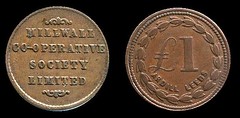
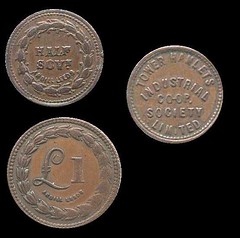
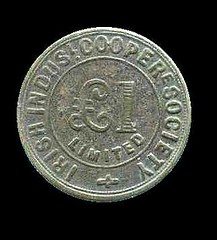
STANFORD SUIT FREEZES GOLD BARS SLATED FOR EXHIBIT
Last week, the U.S. Securities and Exchange Commission charged Texas billionaire Allen Stanford, two associates and three of his companies with "massive, ongoing fraud." The commission got a temporary order to freeze Stanford's assets.
The Gagosian Gallery, which has galleries in New York, Beverly Hills, London and Rome, said it had been unfairly ensnared in the litigation.
In January, Gagosian bought 100 1-kg (2.2-lb) gold bars, from Stanford Coins & Bullion, a subsidiary of another Stanford company.
The parties agreed the money would be wired to Stanford Coins and then transferred to the Dillon Gage Group, an unrelated dealer of rare coins and metals, according to Gagosian's court papers.
But the dealers have refused to send the gold to Gagosian, citing the order to freeze Stanford's assets.
To read the complete article, see: Gagosian Gallery seeks gold frozen in Stanford case (http://www.forbes.com/feeds/reuters/2009/02/27/
2009-02-28T004201Z_01_N27379383_RTRIDST_0_STANFORD-GAGOSIAN.html)
MISSOURI COIN CAPSULE SCAM FLEECES INVESTORS
The order, which can be viewed online, reveals Cooper continued to solicit investments through August 2007, for laser equipment, marketing staff and assembly workers. By January of 2008, however, Cooper told investors that the company “is on financial life support” and “is completely out of money.” None of the investors identified in the order have received a return on their investments.
Records maintained by the Securities Division indicate that neither Cooper nor his two companies, GemSafe Plastics, located in Warsaw, Mo., and World Coin Net, located in Lincoln, Mo., were registered to offer or sell investments in Missouri.
To read the complete article, see: Coin Case Manufacturing Scheme That Cost Missourians Thousands, Shut Down (www.infozine.com/news/stories/op/storiesView/sid/34512/)
OPERATION BERNHARD COUNTERFEITER ADOLF BURGER INTERVIEWED
In the photo, Burger's concentration camp inmate number can be seen tattooed on his left arm. -Editor
 Jewish banknote expert Adolf Burger was part of the team that forged 135 million GBP for Adolf Hitler. The then 27-year-old Jewish banknote expert has told how his team of counterfeiters were "dead men on holiday" as they helped plot the financial ruin of Britain.
Jewish banknote expert Adolf Burger was part of the team that forged 135 million GBP for Adolf Hitler. The then 27-year-old Jewish banknote expert has told how his team of counterfeiters were "dead men on holiday" as they helped plot the financial ruin of Britain.The story was made into a feature film, The Counterfeiters, by Vienna's Stefan Ruzowitzky and won the 2007 Academy Award for Best Foreign Language Film.
Burger, now 91, recently came face to face with some of his handiwork at the Bank of England where he revealed that he and his fellow forgers had tried to mark the notes so British banks could identify them as forgeries.
But the quietly spoken counterfeiter knew that he and his fellow forgers were always just one small slip away from a brutal execution by the SS.
Sitting in his house in the suburbs of Prague, Slovakian-born Burger is more than happy to share his life's story.
The Holocaust survivor still travels to schools, universities and military centres to talk about his wartime employment with the enemy.
"We were dead men on holiday," he said, always aware that the S.S. could turn on him and his comrades at a moment and execute them all.
"I want people to know that the Nazis weren't just murderers but criminals in other ways too. Nobody knew that because the English barred any investigation into the whole affair at the Nuremberg Trials," he revealed.
Burger took only 1,500 GBP for his advice to the movie producers, saying: "I am 90-years-old. What the hell do I need money for?! It is much more important that the story gets told."
"My wife was gassed there and I was deliberately infected with Typhus as part of a medical experiment, but this is irrelevant - it is my personal tragedy," revealed Burger.
And it was only when his special printing skills were discovered that Burger was forced to join the Operation Bernhard forgery scheme.
Burger says some notes were marked in a way that only the forgers could tell.
"After the war when I reported the operation to the British authorities in 1945, bankers came and gave me 250 notes, asking me which ones were forged.
"I held them against the light and said this one is real, this one is not, and so on. About every third note was forged. They didn't believe me, claiming it was impossible to tell," he explained.
But because 1940s banknotes were so large, people often kept them together with a safety pin.
In the workshop several people were occupied with making the notes look used, and pierced the notes with a pin.
However, the counterfeiters pierced the notes right through the Queen's face on the notes – "nothing a loyal English citizen would ever do," laughed Burger.
The Bank of England was so embarrassed by the scam that authorities barred any investigation into the whole affair at the Nuremberg Trials of German war criminals.
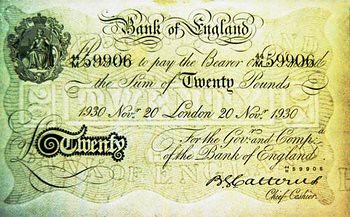
To read the complete article, see: Nazi's counterfeiter's true story (www.thedaily.com.au/news/2009/mar/03/adolf-burger
-nazi-camp-counterfeiter-interview/)
COMMENTATOR PAUL HARVEY, COIN COLLECTOR, DIED AT 90
 Radio broadcast legend Paul Harvey died last Saturday, February 28, 2009. We have mentioned in E-Sylum before he was a coin collector. In a newspaper column this week in Sonora, Arizona, near Phoenix where the Harveys had a home and where he died, writers Earl and Mary Ann Runte (onetime ministers to the Harveys) relate a coin parable that was a favorite of the radio celebrity. They wrote:
Radio broadcast legend Paul Harvey died last Saturday, February 28, 2009. We have mentioned in E-Sylum before he was a coin collector. In a newspaper column this week in Sonora, Arizona, near Phoenix where the Harveys had a home and where he died, writers Earl and Mary Ann Runte (onetime ministers to the Harveys) relate a coin parable that was a favorite of the radio celebrity. They wrote: "I have special remembrance of this great man. One Sunday around the Fourth of July we had a special part in the [church] program in honor of our Country. Along with some patriotic music I read a parable accredited to a historian looking at a penny in the year 2075. That coin was a rare one from his collection.
"The historian wondered what kind of nation the United States was in 1973, the mint date on the coin. The back of the penny was different then. He averred that we must have been an agricultural society – the stems of wheat. A nation concerned about each other – E Pluribus Unum. Metallurgists – the copper coin, and among other things, a religious nation – IN GOD WE TRUST....
"That Sunday in July Paul made his way to the front to ask for a copy of the parable. He was really taken by it. Paul wrote a weekly syndicated column carried by hundreds of newspapers. His column the following week talked about “the little white church on the hill above the car wash.” He talked of the common people who worshiped there and who live in this unique little town. He talked about the little old lady who walked up the hill on a partially paved street to come to worship.
"He made special mention of the parable – he printed it and finished with “IN GOD WE TRUST” and the historian's question, 'I WONDER WHAT HAPPENED?'” Paul would have liked retelling that coin parable.
The writers ended their article "We will miss you Paul … G o o d (pause) Day!"
To read the complete article, see: Remembering Paul Harvey (http://www.sonorannews.com/archives/2009/090304/frntpgHarvey.html)
To read the earlier E-Sylum item, see DEALING WITH CELEBRITY COLLECTORS (http://www.coinbooks.org/esylum_v03n24a07.html)
ARTICLE: BANK OF ENGLAND TO PUT RELIGIOUS LEADERS ON BANKNOTES
I asked Londoner Philip Mernick about it, and he writes: "It seems unlikely, such a proposal would have been widely reported and this is the first I have heard about it!" I also checked the Bank of England web site and found no such announcement. -Editor
The initiative was announced by the Chancellor of the Exchequer and the Bank of England this week.
As well as the Chief Rabbi, whose face will be featured on the 5 note, the currency - due to be issued in August - will carry images of Anglican, Catholic, Muslim and Hindu leaders.
A spokesman for the Bank said: "In these critical times, we must encourage consumers to act responsibly rather than just 'throwing money around'. We are aware that traditionally our banknotes have featured largely unrecognisable historical figures.
"However, by carrying portraits of contemporary personalities, and moreover those who epitomise ethical and spiritual behaviour, we hope that members of the public will take notice of their images and act accordingly."
To read the complete article, see: Chief to be Featured on New £5 Note (http://www.totallyjewish.com/news/national/c-11329/chief-to-be-featured-on-new-5-note/)
COLOGNE, GERMANY TOWN ARCHIVE BUILDING COLLAPSES
We bibliophiles (and often our spouses as well) have nightmares about what could happen if our holdings get out of control. Sometimes that nightmare comes true. Len Augsburger writes: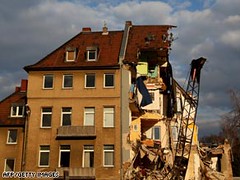 Hundreds of rescue workers continued to search the ruins of the collapsed building in Cologne, Germany, Tuesday for the three people who may be trapped beneath the rubble.
Hundreds of rescue workers continued to search the ruins of the collapsed building in Cologne, Germany, Tuesday for the three people who may be trapped beneath the rubble.The building, which housed the city's historical archive, collapsed, damaging two other buildings -- possibly because of nearby construction underground, CNN's Ben Brumfield reported from the scene.
The building itself was an unremarkable 20th century structure, but the archives it contained were very valuable, said Brumfield, who has done research there.
"Some of the earth underneath the building that collapsed slid into the construction space, which caused a hole under the building," he explained. "The building fell literally into that hole and fell forward into the street.
The building did not collapse quickly, said Carlo Schlender, a reporter for German TV station RTL, a CNN affiliate. That gave people the chance to flee.
There were "a lot of noises before (the collapse). Most of the people could hear that something was wrong and escaped from the scene," he told CNN International's "iDesk" program.
The fire department confirmed that everyone in the archive managed to escape before the collapse of the building, but thought some people working and living in buildings next door were not able to escape.
The city is building a new subway line under the buildings that collapsed, Susanne Motter at the Cologne tourism bureau told CNN. It is not clear if the underground construction played a role in the incident.
The main building which collapsed is the Historic Archive of the city of Cologne, which houses documents up to 1,000 years old.
To read the complete article, see: Collapsed building traps 3 in Germany (www.cnn.com/2009/WORLD/europe/03/03/
germany.cologne.building.collapse/)
FEATURED WEB SITE: THE E-GOBRECHT ARCHIVES
This week's Featured Web Site is The E-Gobrecht Archives. E-Gobrecht is the electronic publication of the Liberty Seated Collector Club (LCSS).
www.seateddimevarieties.com/LSCC.htm
